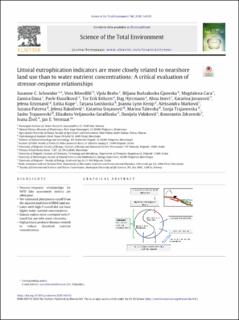| dc.contributor.author | Schneider, Susanne C | |
| dc.contributor.author | Biberdžić, Vera | |
| dc.contributor.author | Braho, Vjola | |
| dc.contributor.author | Gjoreska, Biljana Budzakoska | |
| dc.contributor.author | Cara, Magdalena | |
| dc.contributor.author | Dana, Zamira | |
| dc.contributor.author | Đurašković, Pavle | |
| dc.contributor.author | Eriksen, Tor Erik | |
| dc.contributor.author | Hjermann, Dag | |
| dc.contributor.author | Imeri, Alma | |
| dc.contributor.author | Jovanović, Katarina | |
| dc.contributor.author | Krizmanić, Jelena | |
| dc.contributor.author | Kupe, Lirika | |
| dc.contributor.author | Loshkoska, Tatjana | |
| dc.contributor.author | Kemp, Joanna Lynn | |
| dc.contributor.author | Marković, Aleksandra | |
| dc.contributor.author | Patceva, Suzana | |
| dc.contributor.author | Rakočević, Jelena | |
| dc.contributor.author | Stojanović, Katarina | |
| dc.contributor.author | Talevska, Marina | |
| dc.contributor.author | Trajanovska, Sonja | |
| dc.contributor.author | Trajanovski, Sasho | |
| dc.contributor.author | Veljanoska-Sarafiloska, Elizabeta | |
| dc.contributor.author | Vidaković, Danijela | |
| dc.contributor.author | Zdraveski, Konstantin | |
| dc.contributor.author | Živić, Ivana | |
| dc.contributor.author | Vermaat, Jan E. | |
| dc.date.accessioned | 2021-09-17T08:31:02Z | |
| dc.date.available | 2021-09-17T08:31:02Z | |
| dc.date.created | 2021-02-09T17:51:44Z | |
| dc.date.issued | 2020 | |
| dc.identifier.citation | Science of the Total Environment. 2020, 748 . | |
| dc.identifier.issn | 0048-9697 | |
| dc.identifier.uri | https://hdl.handle.net/11250/2778832 | |
| dc.description.abstract | Biological assessment metrics and water chemistry measurements are used to quantify the link between stressors and their effects on lake ecosystems, for the Water Framework Directive. However, correlations between metrics and water chemistry are often poor. This is seen as major weaknesses of Water Framework Directive-related monitoring and assessment. We analyzed macrophytes, benthic algae, benthic macroinvertebrates, water chemistry and sediment total phosphorus content in the littoral of six lakes in the Western Balkans and used CORINE land use data to estimate nutrient enrichment via runoff from the adjacent land. Lakes with a higher estimated phosphorus runoff from the adjacent land did not have higher littoral water nutrient concentrations, but littoral diatom assemblages indicated more eutrophic conditions. These lakes also had higher abundances of littoral benthic primary producers, which in turn were associated with low concentrations of dissolved nutrients, but only in autumn, not in spring. This is consistent with primary producers taking up nutrients during the summer growth season. In lakes with high abundances of benthic primary producers, it is likely that the littoral vegetation plays a large role in the transfer of nutrients from the water to the benthos. This process impairs correlations between biological metrics and water nutrient concentrations. Our results suggest that CORINE land cover may be more useful to characterize littoral nutrient enrichment than lake water chemistry. Increased benthic primary producer biomasses and “eutrophic” diatom indices may indicate littoral nutrient enrichment even if water nutrient concentrations are low. | |
| dc.language.iso | eng | |
| dc.title | Littoral eutrophication indicators are more closely related to nearshore land use than to water nutrient concentrations: A critical evaluation of stressor-response relationships | |
| dc.type | Peer reviewed | |
| dc.type | Journal article | |
| dc.description.version | publishedVersion | |
| dc.source.pagenumber | 11 | |
| dc.source.volume | 748 | |
| dc.source.journal | Science of the Total Environment | |
| dc.identifier.doi | 10.1016/j.scitotenv.2020.141193 | |
| dc.identifier.cristin | 1888252 | |
| cristin.ispublished | true | |
| cristin.fulltext | original | |
| cristin.qualitycode | 2 | |
